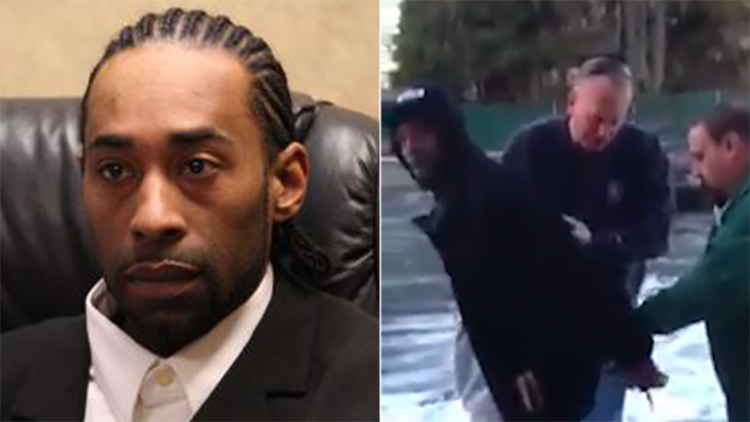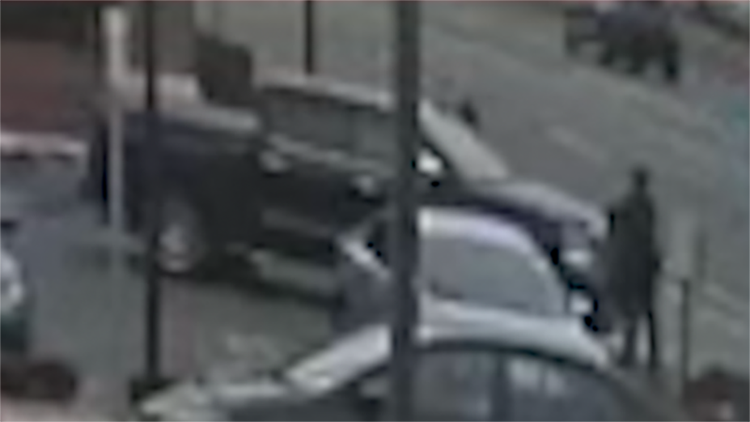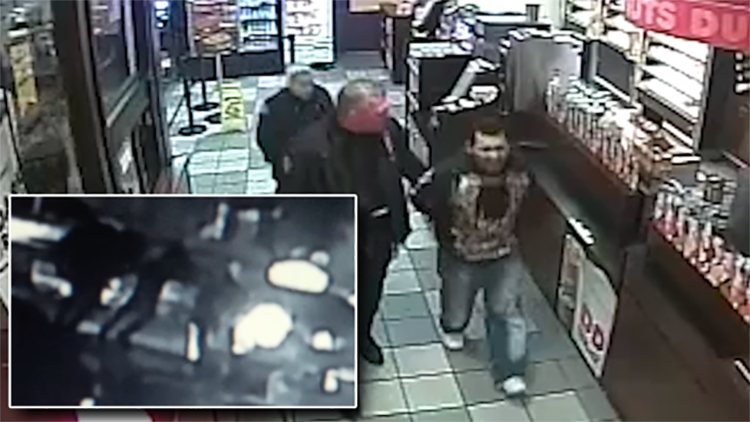The man tasked with defending Nassau County against police misconduct claims offered no defense.
“It’s a very disturbing video,” deputy county attorney Ralph Reissman told a federal judge in February 2019, describing a home-security recording of Nassau police officers throwing a 71-year-old man off his front porch in Baldwin. “It looks like a physically unprovoked attack.”
Two years earlier, the officers had told a different story — one that jailed homeowner Robert Besedin for about a week on charges of harassment, resisting arrest and felony assault, a count that carried a prison sentence of 2 to 7 years.
If I didn’t have the camera, nobody’d believe me.
Robert Besedin
Photo credit: Chris Ware
In that telling, Besedin had slapped 23-year-old Officer Stephen Beckwith’s hand; flailed and kicked against getting handcuffed; and pushed 24-year-old Officer Dominick Mantovani off the porch, causing Mantovani to suffer wrist and back injuries, as well as a sprained ankle “as a result of stumbling down 4 steps.”
The Nassau District Attorney’s Office dismissed those allegations almost a year after Beckwith filed them in a First District Court felony complaint that included the standard warning that “any false statement” is a misdemeanor. Besedin is convinced he won exoneration only because his home-security recording so strongly contradicted Beckwith’s account.
Newsday examined Besedin’s arrest as one of four case histories documenting how civilian video recordings have come into play in evaluating police actions at a time when Nassau and Suffolk county police departments are among a small minority of large U.S. police forces that do not equip large numbers of officers with body cameras.
In three of Newsday’s case histories, including Besedin’s, security or cellphone video captured evidence that contradicted police accounts, prompted judges and prosecutors to dismiss arrests and supported lawsuits that saddled taxpayers with paying more than $4.6 million in compensation so far.
Criminal justice experts concluded after reviewing recordings in the three cases for Newsday that the presence of body-worn cameras may have prevented officers from lodging charges that proved baseless.
The fourth case history demonstrated the limitations of interpreting police actions based on civilian videos, which can be taken at any distance or angle and generally do not include sound. Still, the recording captured the events that led the Nassau County Police Department to issue a wanted alarm based on false information. The events convinced a retired Suffolk lieutenant at the center of the case to call for body cameras as standard police equipment.
Cameras and consequences
Watch and ReadSuffolk County Executive Steve Bellone in early March called for equipping large numbers of officers with cameras after one of the few devices worn on the force captured officers kicking a handcuffed alleged car thief. Two officers were suspended; three were placed on modified duty. Bellone has since included body cameras in the county’s police reform plan.
In a police reform plan approved by lawmakers Monday, Nassau County Executive Laura Curran endorsed widespread body camera use.
‘A really strong contradiction’
At Newsday’s request, two experts in police procedures matched the events captured by Besedin’s security camera against the charges spelled out in the complaint filed against him. Each expert concluded that the video showed Mantovani throwing Besedin from the porch rather than Besedin pushing Mantovani down the steps, as the cops alleged in charging him with assault.
“It seems like a really strong contradiction between what you see in the video from the porch and what the officers report in their affidavit,” said Brandon del Pozo, a former NYPD deputy inspector and Burlington, Vermont, police chief who has done advanced studies in policing and public policy.
There’s no evidence in that video that the suspect pushed them and, in fact, it seems to be the opposite.
Brandon del PozoFormer NYPD deputy inspector and Burlington, Vt., police chief
Photo credit: Paul LaRocco
Referring to Besedin and the two cops, del Pozo added, “There’s no evidence in that video that the suspect pushed them and, in fact, it seems to be the opposite — that the suspect was taken down those steps forcefully by the two officers.”
Asked if the presence of officer body cameras would have changed what had happened to Besedin — either before or after the encounter — del Pozo replied in general terms:
“Body cameras almost always confirm the police account of what happened and supply evidence that strengthens their case, but at the very least, body cameras make police more careful about how they write up an incident, since they know they’ve been recorded.”
Jim Bueermann, a former police chief in Redlands, California, who served as president of the Washington, D.C., nonprofit National Police Foundation, which advances police innovation through science and technology, said he was surprised that Besedin’s video did not lead to serious repercussions for Beckwith and Mantovani.
“In most places, this would have resulted in their termination and prosecution on a variety of offenses,” Bueermann said, referring to possible charges related to official misconduct and making false statements. “It looks like the officer just attacks this guy and throws him down.”
Bueermann also said of the officers’ actions, “I think had they had body cameras they would have had a different outcome.”
In most places, this would have resulted in their termination and prosecution on a variety of offenses.
Jim BueermannFormer police chief in Redlands, Calif.
Photo credit: Paul LaRocco
He added the caveat that proper protocols for using cameras, such as ensuring they’re appropriately activated and that footage is frequently reviewed, are generally necessary to have an effect on how officers approach their work: “If you don’t do those things the cameras are just a little bundle of electronics sitting on the officer’s chest.”
Representing Besedin, civil rights lawyer Frederick Brewington said that he unsuccessfully pushed Nassau District Attorney Madeline Singas’ office to charge Mantovani and Beckwith with filing a false felony complaint, based on “a clear indication that these officers had lied.” A spokeswoman for Singas declined to comment, citing Besedin’s ongoing federal civil rights lawsuit against Nassau County, the police department and arresting officers.
James McDermott, president of the Nassau Police Benevolent Association, which represents the two officers, did not respond to requests for comment on their behalf. Also citing the ongoing civil case, Det. Lt. Richard LeBrun, a Nassau police spokesman, declined to comment on behalf of the officers or Commissioner Patrick Ryder.
Despite the June 2020 repeal of the state law that had completely shielded police disciplinary records, the department denied Newsday’s Freedom of Information Law requests for the results of an internal investigation into Besedin’s arrest. Asked for a summary of the investigation, the department claimed an exemption to state public records law.
Asked for the final disposition of the case or any recommendation of discipline to be imposed against Beckwith and Mantovani, the department claimed “no record(s).”
The events of that day
An Air Force veteran, Besedin worked in an automobile repair shop that had been in his family for seven decades. His 2018 suit against Nassau County and the two police officers alleges false arrest, excessive force, wrongful imprisonment and false statements. Besedin has rejected settlement offers as high as $500,000, according to statements from the county filed in the lawsuit.
Beckwith and Mantovani each had less than 18 months with Nassau police at the time of the Feb. 7, 2017, incident. They remain on the county’s payroll, earning roughly $85,000 at the end of 2019, public records show.
Brewington said that Besedin called 911 on the day of the incident to complain that a neighbor’s trash was blowing onto his property. In its only official statement on the case, released in June 2017, the police department reported that “Besedin called 911 on eighteen different occasions within a five hour-period on the date of his arrest” and “threatened and used profanities towards the Communication’s Bureau 911 Operators.”
Besedin denies intentionally making the calls. Interviewed by Newsday, he said that he had spent the afternoon on a couch, ill with his phone at his side, and was surprised when “911 calls me up and they say I’ve been dialing.”
Brewington acknowledged that “profanity was used” and that the calls brought Beckwith and Mantovani to Besedin’s home at approximately 7 p.m., after dark in February.
The security camera aimed down from above the door. The lens captured part of the porch and front steps. The camera did not record sound. Portions of the frame were cast in light and portions were in shadow.
Here’s what the video shows:
The two officers climb four steps up to Besedin’s porch. Mantovani talks on a cellphone. Out of the field of view, Besedin meets the officers at his front door. They enter Besedin’s house, again out of the field of view. They emerge after about 12 minutes.
Mantovani steps down off the porch. He claps his hands twice at his waist. The back of Besedin’s head comes into view in the bottom right corner of the frame. He is turned to the side, facing in the direction of Beckwith. At the edge of the frame, he talks with Beckwith. They leave the frame.
Over the next four minutes, Mantovani stands at the bottom of the stoop. He looks toward the ground, taps his knuckles on a railing, speaks intermittently and appears to laugh while placing one foot up on a step. Beckwith comes into view and goes out three times for several seconds.
Then Besedin’s left arm appears to move at the bottom of the frame. Mantovani reacts by walking up the steps and putting his left hand on Besedin’s left shoulder. Mantovani goes out of the frame, reappears with his arm around Besedin’s neck and throws Besedin down the steps. A total of four seconds elapses between the movement of Besedin’s arm and his plummet to the ground, head first.
Beckwith follows his partner down the stairs. Mantovani bends toward the ground. Besedin, Mantovani and Beckwith are obscured by darkness. Seen in flashes, the two officers appear to handcuff Besedin.
‘Did violently flail’
Here’s how Beckwith described the encounter in criminal complaints:
Supporting a second-degree harassment charge, a noncriminal violation, Beckwith stated that Besedin “did, with intent to alarm [Beckwith], slap [Beckwith’s] outstretched hand while [Beckwith] was giving the defendant lawful orders to back away from police officers conducting a police investigation.”
To charge resisting arrest — a misdemeanor punishable by up to a year in jail — Beckwith asserted that Besedin “did intentionally prevent police officers from performing an official function by refusing to comply with a lawful order of the police to place his hands behind his back and submit to an arrest.”
Accusing Besedin of the felony second-degree assault, which carried the potential yearslong prison sentence, Beckwith wrote that “the defendant, after being advised that he was under arrest by Officers Beckwith and Mantovani and to place his hands behind his back, did violently flail his arms, kick and scream and push Officer Mantovani down 4 steps on the exterior of his home.
“As a result of stumbling down 4 steps,” Beckwith continued, “PO Mantovani did suffer pain and swelling to his left wrist and back, small lacerations to his hands, and substantial pain and swelling to his left ankle, which was subsequently diagnosed as sprained after receiving medical treatment at South Nassau Communities Hospital.”
Del Pozo and Bueermann said that the video shows no evidence that Besedin “violently” resisted arrest or assaulted either of the officers.
“There’s nothing about the video that shows that the suspect was even in a position to push them down the stairs,” del Pozo said.
Reissman, the deputy county attorney, expressed a similar conclusion during the 2019 hearing on Besedin’s lawsuit.
“I did not see any physical threat or force from Mr. Besedin,” he told U.S. District Court Judge Gary Brown, according to a transcript. “So, it’s a case that I think should be settled without going into years of discovery.”
Once under arrest, Besedin was taken to Nassau University Medical Center for treatment of injuries, including scrapes, bruises and back pain. Brewington said in an interview that Besedin also suffered “post-concussion syndrome.”
‘Torn us inside out’
Charged with assaulting a police officer, Besedin was jailed until his family posted $10,000 bail.
Although Besedin’s son, Robert Jr., retrieved the video and shared it with the Nassau DA’s office soon after his father’s arrest, more than 11 months passed before prosecutors moved to have the case dismissed.
At the time, a spokeswoman told Newsday that Besedin’s actions “did not rise to the legal standard” necessary to prosecute him even for harassment, the least serious charge he faced.
“They walked up to me and never said a word to me,” Besedin recalled of the officers. “Next thing I know I’m being thrown down the steps and handcuffed and taken away in a squad car.”
His son said the injuries led Besedin to relinquish his auto repair business.
“It’s almost torn us inside out. It’s caused a lot of stress, money problems,” said Besedin Jr. “Everybody’s gotten kind of on edge.”
Brewington’s legal practice has included representing minority clients who have alleged racially motivated civil rights violations by police on Long Island. In this case, Besedin, Mantovani and Beckwith are white.
“What happened to Mr. Besedin is something that we all should take to heart, because if it happens to him — a veteran who served his country … what happens to the little Black boy who doesn’t have somebody to stand next to him, or family who can bail him out?” Brewington said.
Asked to explain a possible motive for the officers to have thrown Besedin down his stairs, the attorney speculated that the young officers viewed him as a nuisance.
“They had the chance to simply turn around and walk off his property,” he said. “Instead, what they decided to do was, ‘Hey, let’s just take this old guy in and give him a taste. Maybe he won’t call us again on 911.’”


 CASE N0.2
CASE N0.2
 CASE N0.3
CASE N0.3
 CASE N0.4
CASE N0.4